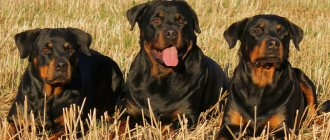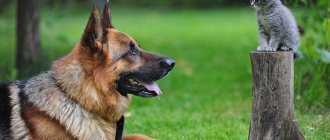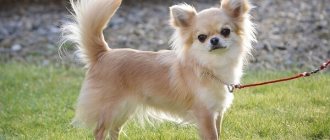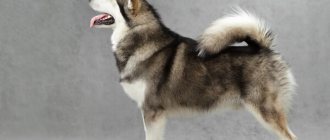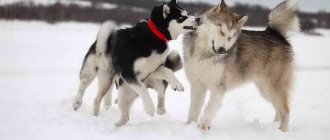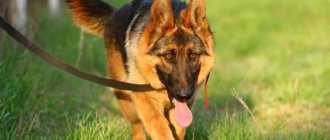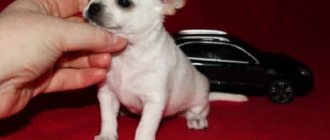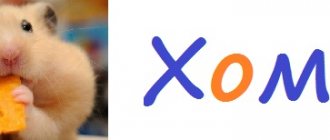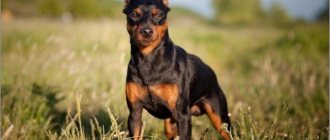The character of a dog depends on heredity and breed characteristics, but proper upbringing and training is also of no small importance. In this article we will tell you about the natural characteristics of the breed and how to properly start raising and training your pet.
The Dobermann is a large German dog breed with an athletic build. They were bred to serve as bodyguards, serve in the army and police, and in the right hands become companion dogs.
- Country of origin : Germany
- Height at withers : male: 68-72 cm; female: 63-68 cm
- Weight : male: 40-45 kg; female: 32-35 kg
- Lifespan : 12-15 years
- Use : Watchman, Security Guard, Companion Dog
- Other names : Doberman Pinscher, Thuringian Pinscher
Content
- The main character traits of a Doberman: female or male?
- Doberman character
- Basic commands
- Raising a dog
In this article you will learn what features of character and behavior are inherent in the Doberman. After studying this information about the temperament and disposition of a Doberman at different ages, you will get an idea about the breed. Find out how the character of a bitch differs from the behavior of a dog. We hope our article will help you figure out which gender of puppy is best for you.
Brief data
Name: Doberman.
Country where the breed was bred: Germany.
Date of appearance of the Doberman: 1890
Height: up to 72 cm (males), up to 68 cm (females).
Body weight: 45 kg (males), 35 kg (females).
How long do Dobermans live: up to 14 years.
The main character traits of a Doberman: female or male?
The Doberman puppy is an active and restless pet. If you take care of and train your puppy, you can avoid pampering. Constant damage to things does not indicate the baby’s bad character, he is just very active and needs somewhere to throw out his energy. You can buy toys for him, he will be active with them, direct his energy to playing with them. Already from 3-4 months (the time of socialization), he is able to perceive the general rules of education. At this time, it is important to begin socializing and training the dog.
Diet
The following products should be included in the Doberman's menu:
- Lean meat (rabbit, turkey, chicken).
- Porridges cooked in meat or fish broth (rice, buckwheat, millet).
- Fresh vegetables (carrots, beans, cabbage, pumpkin).
- Greens (parsley, dill).
- Sunflower or corn oil (in small quantities).
- Fermented milk products (kefir, sour cream, Varenets).
- Dry yeast (no more than one tablespoon).
- Cereal flakes.
Dobermans should be periodically given vitamin and mineral supplements. They can be purchased at a pet store or veterinary pharmacy.
Bitch: character
There is an opinion that Doberman females have a more submissive and gentle character. But experts believe that character largely depends on heredity and individual characteristics. There are always exceptions, bitches with a very difficult character, and there are males with an easy-going and submissive character. But still, there is a difference in the behavior of the sexes. There are advantages and disadvantages for female and male genders.
Advantages:
- Strong relationship with owner and home
- Emotionally sensitive perception
- Girls are smarter and smarter than boys
- Accepts training tasks well
- During walks, he runs less in the bushes
- Doesn't rush at strangers
- The breed is ideal for breeding, just one assessment from the exhibition is enough
Flaws:
- Sly
- Periodic menstruation
Appearance of the animal
The Doberman is a medium-sized dog with a powerful, muscular body, combining noble posture, graceful and clear lines.
The appearance of the animal is distinguished by elegant and clear lines.
The dog has the best anatomical structure. The entire exterior is visible, so it’s difficult to hide flaws. The combination of power, large reserves of internal energy, external grace and aristocratic sophistication gives a good impression of the Doberman.
Main settings
The height of a male at the withers reaches 72 cm, that of a female - 68 cm. Deviations upward or downward of more than 2 cm are considered a significant fault. An adult male Doberman weighs 40-45 kg, a female – 32-35 kg. The Doberman has average parameters and a harmonious build. There are no signs of rough outline or excessive massiveness of the body. The dog is more square than elongated. The height at the withers is approximately equal to the length of the body.
Head
This part of the body corresponds to the general dimensions. When viewed from above, the shape of the head resembles a blunt wedge. The top line from the front looks even and does not fall towards the ears. The transition between the forehead and nose is visible, but not very pronounced. The jaw muscles are well developed, the dog has no cheeks.
Muzzle
The length of this part practically coincides with the corresponding parameter of the skull. The opening of the mouth reaches the molars. The opening of the mouth is wide. The nose ends in a large, but not protruding, black lobe. Lighter shades are allowed if the animal has the appropriate color.
The jaw muscles on the muzzle are well developed.
Dry lips fit tightly to powerful, wide jaws. A scissors bite is considered correct.
Eyes and ears
The eye shape is oval, medium length. The iris is dark brown. Light Dobermans may have other eye colors. Dobermans have high-set ears. After docking, they stand upright. In some countries, such procedures are prohibited. Dobermans' undocked ears hang down, but do not fit too tightly to the head.
Frame
The dog has a straight, long neck with well-developed muscles. The back begins with prominent withers. The lumbar region is short. For bitches, slight elongation of this part of the body is allowed. The croup is rounded. The chest is wide and convex, with slightly prominent ribs. Its anterior part is well developed. The optimal depth of the chest is equal to half the height of the animal.
Tail
This part of the dog's body is set high. When docking, only 2 vertebrae are left. If such a procedure is prohibited, a natural tail is left.
The Doberman's tail is set high.
Paws
The stance of the forelimbs is straight and vertical. The muscles are well developed. The hind limbs are set parallel. Most of the muscles are concentrated in the thigh area. Both the front and hind legs are short, with arched toes that form a ball and end in dark, thick claws.
Wool
The Doberman's hair is short, smooth, and stiff. It fits tightly to the skin and is evenly distributed throughout the body. This breed has no undercoat.
Color
The standards recognize black or brown Dobermans. The presence of red spots with clear boundaries is mandatory.
Male: character
Advantages:
- High performance, very durable
- Solid appearance, a big plus for exhibitions
- Persistence in achieving results in the learning process
Flaws:
- Independent and more stubborn than a girl. Requires more strict training than a girl.
- To fulfill your physical and natural needs, you need a longer time for walks. According to physiology, he is not capable of quickly emptying the bladder.
- Can run away from its owner if it smells a female in heat.
- During the period of estrus in females, fights with other males are possible.
Disqualifying Faults
Significant defects due to which a dog is not allowed to participate in exhibitions are:
- discrepancy between the appearance and gender of the animal (female in male type and vice versa);
- yellow or blue eyes;
- malocclusion;
- wavy or elongated coat;
- presence of hairless areas;
- white spots;
- lack of teeth;
- excessive nervousness, cowardice, aggression.
Excessive nervousness is a disqualifying fault.
Is it possible to influence and correct the character of the Doberman?
Raising and training a Doberman is of great importance, as soon as you bring him into your home. Do not allow people to chew things, stop attempts to pester strangers while walking, do not allow them to eat from someone else’s hands, pick up food from the floor, or beg for food from you while eating. It is forbidden to jump on and bite people, even to show your love. Only training and proper upbringing will change a dog’s character for the better. The puppy training process is based on the method of motivation, encouragement and praise. It is prohibited and unacceptable to treat the dog harshly during training.
Color
The hair is black, with dark red markings. Light hair is found on the face, paws, thighs and near the anus. Some Dobermans can be light brown or bluish in color. In 1976, white Dobermans were registered by breeders. Albinos had serious health problems and short life expectancy.
Defects of the standard:
- Poorly expressed sexual dimorphism.
- Small or too large volume of the cranium.
- Protruding eyes.
- Weak lower jaw.
- Excessively long neck.
- Angularity of the limbs, light color of the claws.
- Long coat, presence of undercoat.
- Hyperexcitability and severe aggressiveness.
Doberman character
The Doberman is usually friendly and becomes very attached to its owner and his family members. Has moderate aggression and moderate excitability. The Doberman is a service dog, so it is necessary to take an obedience course and pay attention to the presence of a protective and fighting instinct, firmness and courage of character. Of particular importance for exhibition animals is self-confidence and courage while maintaining good contact with the owner.
Health, typical diseases
Dobermans, despite the active breeding work that was carried out on them, have good health and do not have many genetic diseases. The life expectancy of representatives of this breed is on average 13-16 years.
As a rule, Dobermans do not suffer from diseases typical of service dogs. Metabolic disorders, epilepsy, and ophthalmological pathologies are diagnosed in rare cases. Hereditary pathologies include:
- dysplasia of the hip and elbow joints;
- intermittent claudication (panostitis);
- Wobbler syndrome (chronic displacement of the cervical vertebrae, dislocations, subluxations);
- von Willebrand-Jurgens syndrome (blood clotting disorder due to platelet pathology);
- hypothyroidism (dysfunction of the thyroid gland due to lack of hormones).
Dobermans sometimes have cardiomyopathy (a pathology of the heart muscle that has lost tone). Main symptoms: decreased stamina, cough, blue skin, apathy. The disease can occur in acute and chronic form. With the first, the risk of death is high, with the second - deterioration of the animal’s condition.
In addition, representatives of this breed are at risk for deadly pathologies - volvulus, gastric torsion. The disease is characterized by the displacement of part of an organ, its incorrect position due to sudden movement while running or during exercise.
Tissues deprived of blood circulation die, leading to sepsis and death. A sad outcome can be prevented only in cases of timely surgical intervention.
Separately, it is worth mentioning the vicious type, subject to genetic mutation. The white variety of Dobermans, which does not meet the standard, has a whole bunch of genetic diseases, among which photophobia and melanoma only open the depressing list.
How to raise a Doberman puppy
If you train your pet correctly, then over time you will get an obedient dog that will follow all commands and delight you every day. Experts believe that several factors may influence the Doberman's susceptibility to following various commands:
- pet's temperament - the speed of the pet's reaction to stimuli, both positive and negative;
- character - how exactly the dog resists various unpleasant influences;
- obedience - the dog’s ability to accept human leadership;
- vigilance - the speed with which the dog notices potential danger, both in relation to itself and in relation to the owner;
- aggressiveness - the pet’s ability to react hostilely to potential danger;
- curiosity - interest that is developed when a dog feels, hears and sees something;
- sociability - the ability to interact with people;
- possessiveness is the interest shown by animals in certain objects, for example toys.
How quickly your dog will learn commands depends on which traits predominate in the character of a Doberman puppy. By paying attention to the character traits of your animal, you can find an approach to it and adjust its behavior in certain situations.
- Eagerness will get you nowhere . You should not try to teach a Doberman puppy all the commands at the same time; you need to learn the commands one by one. You need to have patience and act methodically. You should not scold your pet at the moment when he makes mistakes, and when he succeeds in something, then the pet should be encouraged.
- Don't hit . It is prohibited to use physical punishment against a pet. You should limit yourself to variable intonation, but avoid shouting. After the Doberman puppy turns three months old, it is allowed to use a light spank as punishment while saying the phrase “Ugh.” It is necessary to punish immediately when the animal commits an offense, and not after it, since the animal simply will not understand what exactly it was punished for.
- Subsequence . The main goal is to ensure that the pet follows the command the first time. Commands should be pronounced clearly and in an even voice so that the dog understands and obeys you. All family members should be involved in raising the dog, but they must act together. It is forbidden to allow situations in which you scold the puppy, and another family member praises him or simply does not pay attention.
- Pamper . Remember to reward your Doberman puppy with a variety of treats and praise when he has done what is asked of him.
Basic commands
You will use some commands more often, others less often. But they will still come in handy to easily interact with the Doberman and even keep him safe in various situations.
- Aport. One of the most difficult teams. Many people perceive it as very easy and simple, but with many dogs you will have to work hard. This skill is used for other exercises: searching, searching, selecting an item and many others. Usually they are all used in service. When working out a command, “Aport” and “Give” are used, and a gesture is also used.
- Give. On the command “Give” the dog must give up the object.
- Lie. A connecting command that needs to be learned for other commands. In addition, it will not interfere at home or on the street.
- To me. You will need to use this command quite often. So start with it immediately after your Doberman puppy has learned his name. Never call the dog to punish, and do not scold if it comes on its own, even after mischievousness before it. This behavior on your part may alienate the animal.
- Place. A puppy or an adult dog must clearly know where his place is located. He can sleep anywhere, if you allow it, of course, but he must know this command. You can use it outside the home, marking the place with a leash or your favorite toy.
- Near. It is possible to teach your pet the “Near” command at any age, be it an adult dog or a small puppy. When you move to a new home, you should immediately think about training your puppy.
- Sit. One of the very first commands that a Doberman puppy should learn.
- Stand. The command is useful in everyday life, for example, for combing a dog.
- . The prohibiting command is one of the most mandatory and taming it begins from the first day the puppy appears in the house. Requiring the command “Fu!”, “No!”, “No!” - immediately stop the unwanted action.
Pet care
The short-haired Doberman is well suited for keeping in apartments. If a dog is purchased for a private home, a spacious enclosure with a booth is built as a home for it. In cold weather, it is better to let the dog indoors. The enclosure is located in a shaded area, since the Doberman does not do well in the heat. The earthen floor is covered with wooden boards installed on supports 10-20 cm thick. If possible, a heating system is installed from a number of infrared heaters.
If the puppy lives in the house, a place to sleep is set up in a warm, clean room. The dog is extremely active; after a long run, it should not be allowed to lie down on an unheated floor. The dog may catch a cold, which will cause an unpleasant disease - muscle inflammation. There is no need to cancel your walk in rainy weather. However, after it the dog is taken into a heated room, where it dries and warms up.
Hygiene and bathing
The dog's coat does not require complex care. There is no need to comb it too often. Once a week, the dog’s body is wiped with a damp towel.
Bathing helps strengthen the animal's immunity.
After this, massage the skin with a stiff brush. Dobermans should not be bathed often. It is enough to carry out the procedure once every 6 months. Experienced dog breeders believe that frequent bathing weakens the immune system, which causes the animal to constantly become ill. It is safe to wash dirty paws after a walk.
Your pet's eyes and ears should be examined regularly. Any dirt that appears is removed with a cotton pad moistened with water. Nails are trimmed as needed. In an active dog, they gradually wear off during walks. Sleeping and eating areas must be kept clean. Food and water bowls are washed after each feeding.
The Doberman needs increased physical activity. The walk should last at least 2 hours. In the absence of warm clothing for dogs, the duration of walking in winter is reduced.
Dog food
It is allowed to feed Dobermans with natural products or ready-made diets. When creating a menu, adhere to the following recommendations:
- Premium dry food is intended for dogs with normal body weight. If a pet weighs more than 25 kg, it needs to be fed a diet that prevents the development of obesity.
- When a dog is fed natural products, most of the menu should consist of meat. The best variety is considered to be lean veal. An adult dog should consume at least 1 kg of this product per day. You cannot replace it with pork, offal or minced meat.
- The diet should include porridge cooked in water, vegetables (zucchini, pumpkin, carrots), and cottage cheese.
Solid food for older dogs is softened by soaking in kefir. This method is not used when feeding young animals.
Raising a dog
Education is the process of shaping Doberman behavior acceptable to the owner, when this behavior is not regulated by commands.
During upbringing, a dog develops relationships with its owner, family members, passers-by, behavior in the house, on the street, and relationships with other dogs. The training process begins immediately when the dog first appears in the house and continues throughout the dog’s life. Regardless of the dog's breed, it must be trained. Just as people do not like ill-mannered people, dogs should also know what is allowed and what is not allowed. Raising a dog is a rather complex process, which is not limited to learning just a few commands. The main goal of education is that the dog should become pleasant to talk to. In addition, it must be manageable at some points, otherwise it will be very difficult for the dog owner. In the broadest sense of the word, dog training is about teaching the dog commands such as “Bad” and “No”. But besides this, the dog must know what is good and what is bad, even in those moments when the owner is not around. Some believe that the Doberman only understands commands, but cannot generalize. Only those who, as a rule, never had dogs, and studied them only in laboratory conditions, in which dogs were not able to show their full potential, are convinced of this, as well as those who, due to their personal qualities, were unable to establish a relationship with pet. In real life, the Doberman is a pack animal and therefore, like any other pack animal, needs to communicate with members of its family. In this situation, the dog’s family members are people. It is quite stupid to think that if a dog caresses you, this means that his skin is itching. In order for a dog’s nervous system to function normally, it needs affection, love, communication, and praise. In addition, so-called “inhibiting factors” are required, because if the dog is allowed everything, then this will not lead to anything good. When raising a Doberman puppy, you should pay attention to the genetic characteristics of the breed. A family is a pack in which there must be a leader, in this case the leader is a person. The leader punishes, plays, feeds, caresses, praises and scolds. All other members of the owner's family are ranked by rank. At that moment, while the puppy is small, all other family members are senior to him. However, in the process of growing up, around the age of one year, the dog begins to look for its place in the hierarchical pyramid. Naturally, she will try to take the step that is as high as possible. She can do this with the help of force, in the case of large dogs, or with the help of cunning, as small dogs do. The more ill-mannered the dog is, the more difficult this process will be. If the owner from the first days shows his pet that the one who has the power is right, then he will turn out to be a frail neurotic or an evil beast with whom you will hardly communicate with joy. A Doberman puppy must understand that he must obey people, since they love him, feed him, and raise him. Understand that prohibitions are not the whim of the owner, but a way to protect everyone from trouble. The main influence on the dog should be the voice. From the first days of being in your home, the puppy must realize that you love him, and if you raise your voice, then this means that he is doing something wrong. One of the best incentives for a pet is considered to be a treat, which should be given out for good behavior and listening to commands. Character of the Doberman: who is better to take a bitch or a dog
Breed Features
Male and female individuals differ slightly in character.
Female
The difference between the characters of the female and the male is that she is more affectionate. Most likely, this is due to the presence of maternal instinct. In addition, she is overly cautious with strangers. Female Doberman Pinschers will watch for strangers who come into the house, all the time they are there, all the time waiting for any danger. But she is always ready and will be able to stand up for her owners if necessary. In addition to the above, females are very friendly towards other animals, show interest in children, taking care of them, and never mind running and frolicking with the owner.
Male
The character of the male Doberman is hot-tempered and aggressive. With proper training, these qualities can be controlled. Males must understand that they are the ones who obey the owner, and not vice versa. Then there will be no problems with the pet.
Another difference from females is the fact that males are much better at hunting.
REFERENCE! If your goal is to get a hunting partner, then choose a male Doberman.
Advantages of the breed:
- Loyalty to its owner.
- Their ability to read the mood of the owner.
- The Doberman is a good guard and hunter.
- Good mental abilities.
- Wary of any strangers.
Disadvantages of the breed:
- Aggressiveness.
- The desire for independence.
- Obstinacy and self-will.
- Hot temper in males.
